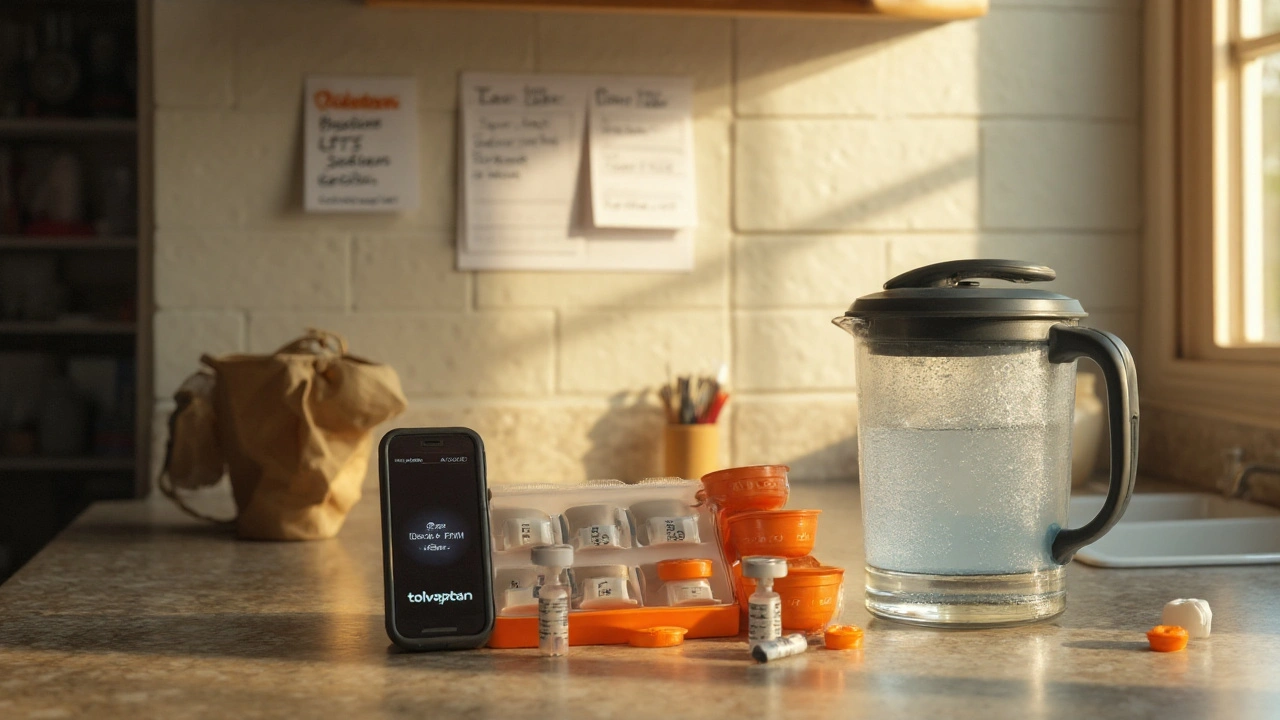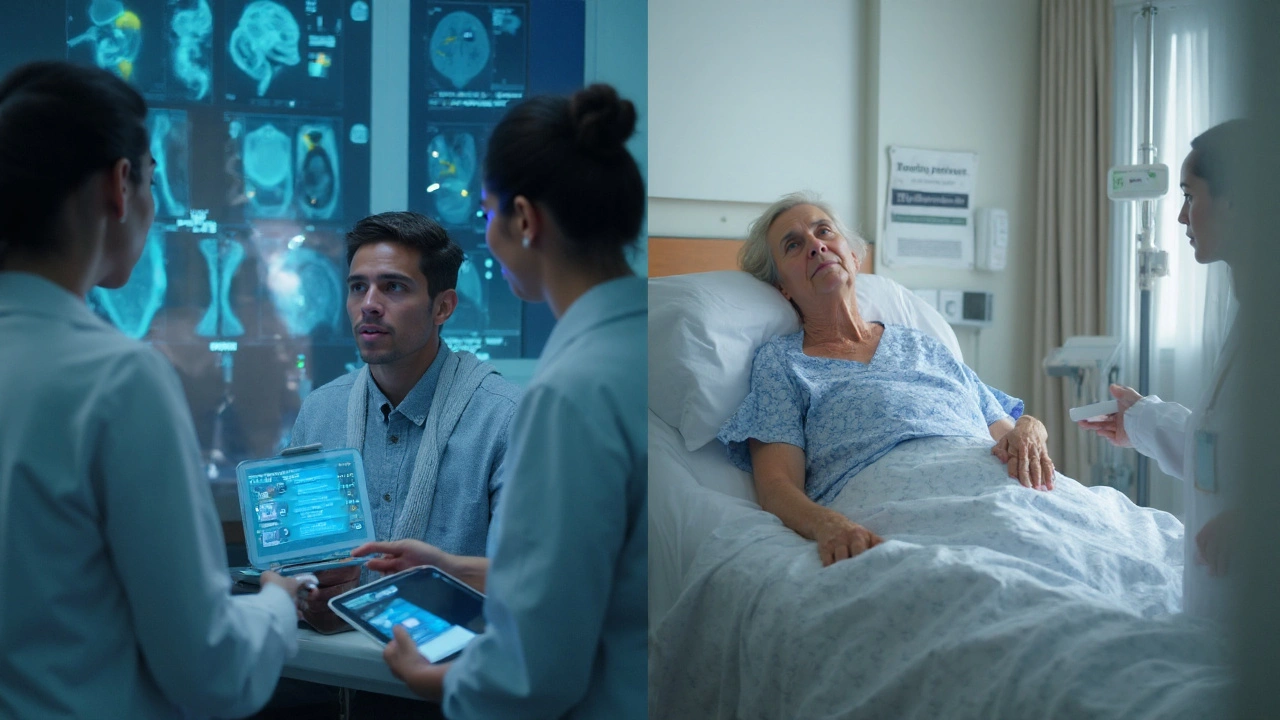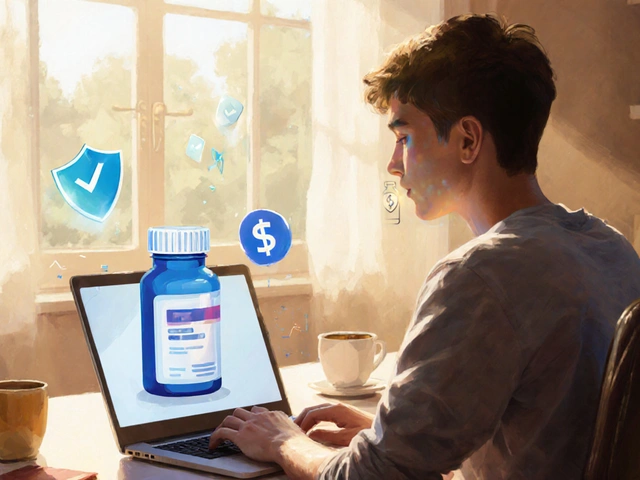Personalized medicine sounds glamorous until you’re the one deciding whether a drug fits your life, your risks, and your values. Tolvaptan sits right at that crossroads. It can slow kidney decline in autosomal dominant polycystic kidney disease (ADPKD) and correct sodium in SIADH, but only when used thoughtfully-with the right patient, dose, timing, and monitoring. Expect clear decision points, practical checklists, and realistic trade-offs, not hype.
TL;DR / Key takeaways
- Tolvaptan is a selective V2 receptor blocker. In ADPKD, it lowers kidney cyst growth signals (cAMP) and slows loss of kidney function; in SIADH, it increases free water excretion to raise serum sodium.
- Best results come from personalization: identify rapid progressors (ADPKD) or the right clinical context (SIADH), titrate dosing by symptoms and urine osmolality, and monitor liver enzymes on a strict schedule.
- Evidence: TEMPO 3:4 (NEJM 2012) halved kidney volume growth and modestly slowed eGFR decline; REPRISE (NEJM 2017) confirmed benefit in later-stage ADPKD. SALT-1/2 (NEJM 2006) showed meaningful sodium correction in SIADH. EVEREST (NEJM 2007) improved symptoms in heart failure hyponatremia without mortality benefit.
- Risks: aquaresis (thirst, frequent urination), potential liver injury (~4-5% significant ALT rise in trials), too-rapid sodium correction (SIADH), and drug interactions via CYP3A. Pregnancy and breastfeeding are not recommended.
- Inside: candidacy checklists, dosing/monitoring playbook, examples, pitfalls to avoid, and a quick decision guide you can take to your next appointment.
Personalizing therapy: who, when, and how it works
What jobs are you trying to get done after clicking this? Most readers want to: 1) confirm if tolvaptan is a fit; 2) understand dose choices and monitoring; 3) weigh benefits against everyday side effects; 4) see what data actually supports it; 5) plan next steps with their care team. Let’s hit those directly.
Mechanism in plain terms: Tolvaptan blocks vasopressin’s V2 receptor in the kidney’s collecting ducts. In ADPKD, vasopressin drives cAMP, which fuels cyst formation and growth; blocking it reduces cyst expansion and preserves function. In SIADH, vasopressin is inappropriately high, so blocking it lets you excrete free water, concentrating less urine and raising blood sodium.
Who benefits most (ADPKD): people at high risk for fast progression. Clinicians often use the Mayo Imaging Classification (age + height-adjusted total kidney volume) to define risk (classes 1C-E). Genotype and clinical factors (PROPKD score: PKD1 truncating mutations, early hypertension, urologic events, male sex) raise alarms. A rapid historical eGFR decline (for example, ≥3 mL/min/1.73 m² per year) or large kidneys for age also point to benefit. Most countries start around eGFR ≥25 mL/min/1.73 m², aligned with the pivotal trials.
Who benefits most (SIADH): patients with persistent, symptomatic, or moderate-to-severe hyponatremia (often Na <130 mmol/L) when fluid restriction fails or isn’t feasible, especially in euvolemic causes (like cancer-related SIADH or postoperative SIADH). Because sodium can rise fast, many centers initiate in-hospital with frequent labs.
What to expect from the evidence:
- TEMPO 3:4 (NEJM 2012): annual total kidney volume growth fell to ~2.8% vs ~5.5% with placebo; eGFR decline slowed by about 1 mL/min/1.73 m² per year over 3 years.
- REPRISE (NEJM 2017): in later-stage ADPKD, eGFR decline improved by ~1.27 mL/min/1.73 m² per year vs placebo over one year.
- SALT-1 and SALT-2 (NEJM 2006): in SIADH, serum sodium increased meaningfully within 24-48 hours and maintained while on therapy.
- EVEREST (NEJM 2007): in heart failure, symptoms and sodium improved; no mortality advantage.
Real-world trade-offs: Daily life changes matter more than p-values. Most people on tolvaptan urinate often and drink more water. Many adjust fine with planning; some stop because it’s too disruptive. Liver enzyme checks are non-negotiable. This is medicine you live with, not just take.

The playbook: candidacy, dosing, monitoring, and everyday life
Start with a quick self-audit you can bring to your clinician. This isn’t medical advice-it’s a conversation primer.
ADPKD candidacy checklist
- Diagnosis: ADPKD confirmed (family history, imaging, or genotype).
- Risk of rapid progression: Mayo 1C-E or high PROPKD score; large kidneys for age; eGFR slope suggests faster decline.
- Kidney function: many regulators approve starting at eGFR ≥25 mL/min/1.73 m²; earlier may yield more benefit.
- Liver health: baseline AST/ALT, bilirubin normal; no active liver disease.
- Pregnancy: not pregnant; using effective contraception; not breastfeeding.
- Life fit: can manage frequent urination at work/school; has access to regular labs.
- Medications: no strong CYP3A inhibitors (e.g., ketoconazole, clarithromycin) or inducers (e.g., rifampin); avoid grapefruit.
SIADH candidacy checklist
- Confirmed diagnosis: true hypotonic hyponatremia; euvolemic; SIADH criteria met (low serum osmolality, inappropriately high urine osmolality & sodium, normal thyroid/adrenal).
- Cause considered: malignancy, CNS disease, pulmonary disease, drug-induced-treat cause when possible.
- Failed or unsuitable: fluid restriction, salt tablets/loop diuretics, or urea therapy.
- Monitoring capacity: can check sodium every 6-8 hours initially; inpatient start is common to avoid rapid correction.
Dosing and titration (ADPKD)
- Split-dose strategy: morning dose larger than afternoon (e.g., 45/15 mg → 60/30 mg → 90/30 mg). Titrate over 1-2 weeks based on tolerability and labs.
- Pharmacodynamic cue: many clinicians aim for a drop in urine osmolality (Uosm) to <300 mOsm/kg or a ≥50% reduction from baseline-signs the V2 blockade is doing its job.
- Hydration: drink to thirst; keep water nearby; expect 4-6 liters of urine in early weeks until you settle on a dose you can live with.
- Timing: take the morning dose early; take the afternoon dose mid-day to lessen nighttime bathroom trips.
Dosing and precautions (SIADH)
- Typical start: once daily 15 mg, then 30 mg or 60 mg as needed. Many centers start in the hospital.
- Safety rule: avoid correcting sodium more than 8-10 mmol/L in 24 hours (slower in high-risk patients). If sodium rises too fast, pause therapy and give free water or dextrose per protocol.
- When not to use: hypovolemic hyponatremia; urgent neurologic symptoms needing hypertonic saline; inability to monitor labs closely.
Liver safety monitoring
- Schedule commonly used in the U.S.: baseline, at 2 and 4 weeks after starting or increasing dose, monthly for 18 months, then every 3 months. Canada and the EU follow similar frequent early monitoring per product monographs.
- Stop and evaluate if ALT/AST >3× ULN with symptoms or bilirubin rise. Most elevations resolve after stopping; re-challenge depends on severity and specialist judgment.
Daily-life pro tips (from clinics and patient reports)
- Test-drive: start on a Friday; map bathroom access; keep a water bottle and electrolyte plan.
- Sleep: move the second dose earlier in the afternoon; limit late-evening fluids.
- Heat and travel: carry water; don’t skip doses on long flights without a plan; ask about dose timing across time zones.
- Illness: if you can’t keep fluids down or are fasting for a procedure, hold tolvaptan and call your team to avoid dehydration and sodium spikes.
- Work realities: jobs without easy bathroom access (drivers, teachers) may need a lower dose or a tailored schedule.
What success looks like
- ADPKD: stabilized or slower eGFR decline compared with your prior trend; kidney volume growth rate reduced; manageable aquaresis; normal liver labs.
- SIADH: sodium in a safe range with monitored, gradual correction; clear thinking and fewer symptoms; manageable thirst and urination.
Side effects and how to handle them
- Aquaresis (very common): plan fluids and bathrooms; discuss dose adjustments if it affects work or sleep.
- Thirst/mouth dryness: sugar-free lozenges, scheduled sips, consider adding a small amount of electrolytes if advised.
- Liver enzyme rise (~4-5% significant): this is why the lab schedule exists; act early if fatigue, right-upper-quadrant pain, dark urine, or jaundice appear.
- Headache/dizziness: review blood pressure, hydration, and other meds.
Drug interactions and contraindications
- Avoid strong CYP3A inhibitors (e.g., ketoconazole, clarithromycin) and grapefruit; inducers (e.g., rifampin, St. John’s wort) can reduce effect.
- Be cautious combining with diuretics; monitor volume status and electrolytes.
- Not recommended in pregnancy or breastfeeding; discuss contraception before starting.
Where personalized medicine is headed
- Better risk tools: integrating imaging (Mayo class), genotype (PKD1 truncating vs non-truncating), and clinical history (PROPKD) to time therapy and set expectations.
- Monitoring smarter: using Uosm as a real-time pharmacodynamic marker; remote lab reminders; digital symptom diaries to tailor dose.
- Combination ideas: research is exploring add-on therapies (e.g., SGLT2 inhibitors) in ADPKD, but these aren’t established yet; enrolling in trials is how we learn.
- New vaptans: lixivaptan is under study for ADPKD with hopes for a different liver safety profile; results will steer options.
Decision tools, examples, and checklists you can use
Two-minute decision guide (ADPKD)
- Age & kidneys: Are your kidneys large for age (Mayo 1C-E)? If yes, benefit more likely.
- eGFR: Is it ≥25? Earlier start generally preserves more kidney function.
- Past pace: Has eGFR fallen ≥3 mL/min/1.73 m²/year? That argues for starting.
- Life setup: Can you handle frequent urination and monthly labs for 18 months?
- Deal-breakers: active liver disease, pregnancy, or strong CYP3A interactions.
Two-minute decision guide (SIADH)
- True SIADH confirmed? Check hypotonicity and exclude thyroid/adrenal issues.
- Severity and symptoms? Headache, confusion, falls risk push toward active therapy.
- Have you tried fluid restriction or urea? If not feasible/effective, consider tolvaptan.
- Can you monitor sodium frequently at first? If not, reconsider.
ADPKD example 1: starting early
Maya, 32, eGFR 85, Mayo class 1D, PKD1 truncating variant, and a family history of dialysis in the 40s. She starts 45/15 mg, titrates to 60/30 mg by week 2. Her urine osmolality drops from 600 to 260 mOsm/kg on therapy, thirst is intense for 10 days, then manageable. Over year one, her eGFR slope improves compared with her pre-treatment trend. Monthly liver labs stay normal.
ADPKD example 2: later start with real-life constraints
Dan, 56, eGFR 32, Mayo 1C, teaches high school. He opts for 45/15 mg and shifts his second dose to early afternoon to control nocturia. He accepts a modest eGFR benefit to keep his classroom rhythm. A year in, slope improves; he hasn’t needed to increase the dose because his quality-of-life trade-off is set.
SIADH example: safe correction matters
Rita, 68, Na 122 mmol/L from lung cancer-related SIADH. Fluid restriction failed. She starts 15 mg in the hospital; sodium checked every 6 hours. It rises by 5 mmol/L in 24 hours-right on target. She discharges on 15 mg with outpatient labs twice weekly for the first two weeks. When chemo changes, SIADH eases and she stops tolvaptan.
Common pitfalls and fixes
- Starting too late: waiting until eGFR is very low (e.g., <20) shrinks potential benefit. If high risk earlier, discuss sooner.
- Over-aggressive dosing: aquaresis derails adherence. Aim for the lowest dose that hits urine osmolality targets you can live with.
- Skipping liver labs: that’s the one line you don’t cross. Put reminders in your phone; link labs to your dose refills.
- Travel without a plan: dehydration risk is real. Pack water, electrolytes, and a one-page medication summary.
- SIADH self-management: do not try to self-correct sodium at home. Rapid shifts can be dangerous. Partner with a clinical team.
Alternatives and where they fit
- ADPKD: optimal blood pressure control (ACEi/ARB), low-sodium diet, avoiding nephrotoxins, treating cyst complications. SGLT2 inhibitors have cardio-renal benefits in CKD broadly, but their role in ADPKD is still being studied.
- SIADH: treat the cause; fluid restriction; oral urea; hypertonic saline for acute symptomatic cases; demeclocycline in select situations when other options fail (watch kidneys).
Cost and access quick notes
- Coverage varies by country/region. In Canada, provincial formularies often follow CADTH criteria emphasizing rapid progressors; in the U.S., a REMS program governs liver monitoring. Keep documentation (imaging class, eGFR slope) for prior authorization.
- Ask about patient support programs for education, lab reminders, and copay help.

FAQ and next steps / troubleshooting
Is there a perfect time to start in ADPKD?
There isn’t a single number, but starting while eGFR is reasonably preserved and risk of rapid progression is clear tends to yield more kidney years. That’s why Mayo class and prior eGFR slope matter.
How long do people stay on it?
ADPKD: usually long term, until approaching kidney failure, intolerable side effects, or a change in goals. SIADH: as long as the underlying cause persists and sodium control requires it-sometimes short term, sometimes longer.
What if my liver enzymes rise?
Follow the protocol: repeat labs quickly; hold therapy if thresholds are crossed; assess symptoms. Many patients can resume at a lower dose after normalization, but significant injury means stopping for good. Decisions are individualized.
Can I take it with diuretics, ACE inhibitors, or SGLT2 inhibitors?
Often yes with careful monitoring. Diuretics can compound volume loss; check blood pressure, creatinine, and electrolytes. ACEi/ARB are standard in ADPKD for blood pressure and proteinuria. SGLT2 use in ADPKD is investigational; discuss in a trial context.
Pregnancy and contraception?
Tolvaptan isn’t recommended in pregnancy or breastfeeding. Use reliable contraception and plan ahead if pregnancy is on your horizon. Bring this up before starting.
What about alcohol or grapefruit?
Alcohol can worsen dehydration; be cautious. Avoid grapefruit and strong CYP3A inhibitors entirely-they spike drug levels.
My job doesn’t allow frequent bathroom breaks. Any options?
Yes: choose a lower dose, shift dose timing, and dial in hydration patterns. Some people try a weekday/weekend dosing pattern, but make changes only with your clinician since consistency matters for ADPKD benefit.
What if sodium corrects too fast on SIADH treatment?
This is an emergency protocol situation: hold tolvaptan and give free water or dextrose; consider desmopressin per local guidelines. That’s why initial inpatient monitoring is common.
How will we know it’s working?
ADPKD: watch eGFR trends over months and kidney volume over years; a drop in urine osmolality suggests V2 blockade is on target. SIADH: serum sodium rises in a controlled, gradual way and symptoms improve.
What should I bring to my first specialist visit?
- All lab results (creatinine/eGFR, liver enzymes), prior urine osmolality if available.
- Imaging reports with kidney size/volume; family history details.
- Medication list including supplements; any side effects you’re worried about.
- Your daily routine constraints (work, caregiving, travel) so dosing can be tailored.
Troubleshooting by persona
- Patient with relentless nocturia: move second dose earlier; modest dose down-titration; improve sleep hygiene; revisit caffeine timing.
- Clinician in a small center: standardize a monitoring order set (LFT schedule, sodium checks, Uosm target notes); set reminders in the EMR; provide a one-page patient handout.
- Caregiver managing SIADH at home: maintain a simple log of sodium values, doses, thirst/urination, and any neuro symptoms; know the threshold for calling or going to ED.
Credible sources to discuss with your team
- FDA Prescribing Information for Jynarque/Samsca (latest label updates).
- EMA European Public Assessment Report (EPAR) for Jinarc.
- Health Canada Product Monographs and CADTH recommendations.
- TEMPO 3:4 (NEJM 2012), TEMPO 4:4 extension (Kidney International 2017), REPRISE (NEJM 2017).
- SALT-1/2 (NEJM 2006); EVEREST (NEJM 2007).
Next steps
- ADPKD: ask for Mayo class or htTKV measurement and review your eGFR slope. If you’re 1C-E or have fast decline, discuss starting.
- SIADH: confirm diagnosis and cause; set a monitoring plan that avoids rapid correction.
- Insurance: gather imaging and slope data for prior authorization; check provincial/state criteria.
- Life plan: pick a start date that respects your schedule; set lab reminders; line up hydration and bathroom access.
If you’ve read this far, you’re already doing personalized medicine right: asking how the drug fits the person-not the other way around.








10 Comments
Faye Woesthuis
September 6, 2025 AT 07:27Tolvaptan is a band-aid for people who won't just drink less water. If you're too lazy to manage your own hydration, don't blame the drug. Liver toxicity? That's not a side effect-it's a warning you picked the wrong shortcut.
Stop romanticizing pharmaceuticals like they're magic. This isn't personalized medicine-it's corporate profit dressed in lab coats.
raja gopal
September 6, 2025 AT 21:38This is one of the clearest, most human explanations of tolvaptan I've ever read. As someone from India where access to such detailed guidelines is rare, I’m grateful for this. The checklist alone could save lives.
It’s not just about science-it’s about dignity. People with ADPKD deserve to live, not just survive. Thank you for writing this with both precision and heart.
Kevin Mustelier
September 7, 2025 AT 02:51Personalized medicine? More like personalized capitalism. You’ve got a $100k/year drug that only works if you’re rich enough to afford the monitoring, the time off work, and the emotional bandwidth to navigate a 17-page PDF.
Meanwhile, the real disease is systemic neglect. We’re treating cysts while ignoring why half the world can’t even get clean water.
:/
Keith Avery
September 7, 2025 AT 05:05TEMPO 3:4 showed a 1 mL/min/year eGFR benefit? That’s statistically significant but clinically meaningless. You’re trading 6 bathroom breaks a day for 12 extra months of kidney function? And you call that a win?
And why is no one talking about the fact that SGLT2 inhibitors show better outcomes in CKD with less burden? This feels like a placebo with a prescription pad.
Also, ‘Mayo class 1C-E’-who decided that? Some guy in Minnesota with a spreadsheet?
Luke Webster
September 8, 2025 AT 23:48I appreciate how this post doesn’t just dump data-it meets people where they are. I’m a nurse in rural Ohio, and I’ve seen patients stop tolvaptan because their job won’t let them leave for bathroom breaks.
That’s not noncompliance. That’s a broken system.
Thank you for including the ‘life fit’ checklist. That’s the part that matters most. Medicine shouldn’t require you to become a different person to survive it.
Natalie Sofer
September 9, 2025 AT 08:30OMG this is so helpful!! I just started tolvaptan last month and I was so overwhelmed, but your dosing tips? Life changer. I moved my afternoon dose to 2pm and now I can actually sleep. Also, I spelled ‘osmolality’ wrong like 3 times but I think you get the point 😅
Thank you for not making me feel dumb for needing this spelled out.
Tiffany Fox
September 9, 2025 AT 14:15You did it. You turned a terrifying, confusing drug into something I can actually talk about with my doctor. I’m 34, PKD1 truncating, and terrified of losing my kidneys. This gave me a plan-not fear.
Keep writing like this. People like me need you.
Rohini Paul
September 10, 2025 AT 12:28Interesting. I’ve got a cousin in the US on this drug-she says the thirst is insane, but she’s keeping her eGFR stable. Still, I wonder: if you’re drinking 5L of water a day, are you really saving your kidneys or just delaying the inevitable?
Also, why is liver monitoring so strict? Is it because the drug’s toxic, or because the company doesn’t want lawsuits?
Courtney Mintenko
September 10, 2025 AT 16:08Another cult of pharmaceuticals. You think this is medicine? It’s a performance. A spectacle. You’re not ‘personalizing’ care-you’re performing compliance for a system that profits from your suffering.
They give you a checklist. You check boxes. You feel like a good patient. Meanwhile, your liver is screaming and your bladder is on permanent overtime.
Wake up.
It’s all just a business model wrapped in a white coat.
Sean Goss
September 12, 2025 AT 14:29Let’s deconstruct the evidence base. TEMPO 3:4 used a composite endpoint of kidney volume growth and eGFR slope-both surrogate markers with questionable clinical translation. REPRISE’s 1.27 mL/min/year benefit? That’s a 5.4% relative reduction over one year in a population with median eGFR of 28-effect size is negligible when weighed against the cost-benefit ratio of aquaresis and hepatotoxicity risk.
Furthermore, the SALT trials excluded patients with comorbidities common in real-world SIADH, rendering external validity dubious. This isn’t precision medicine-it’s precision marketing. And the REMS program? A regulatory theater designed to shift liability to the patient, not the manufacturer.